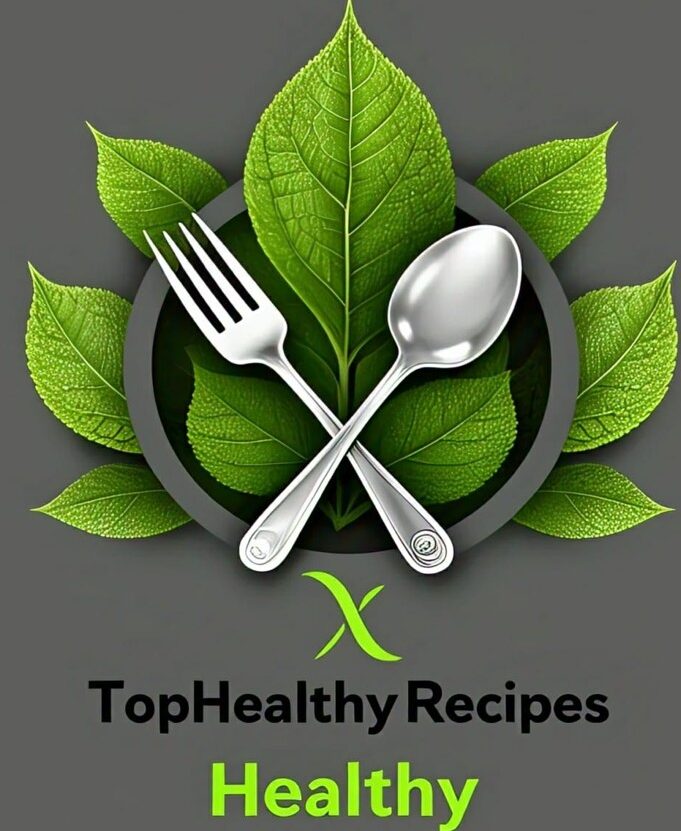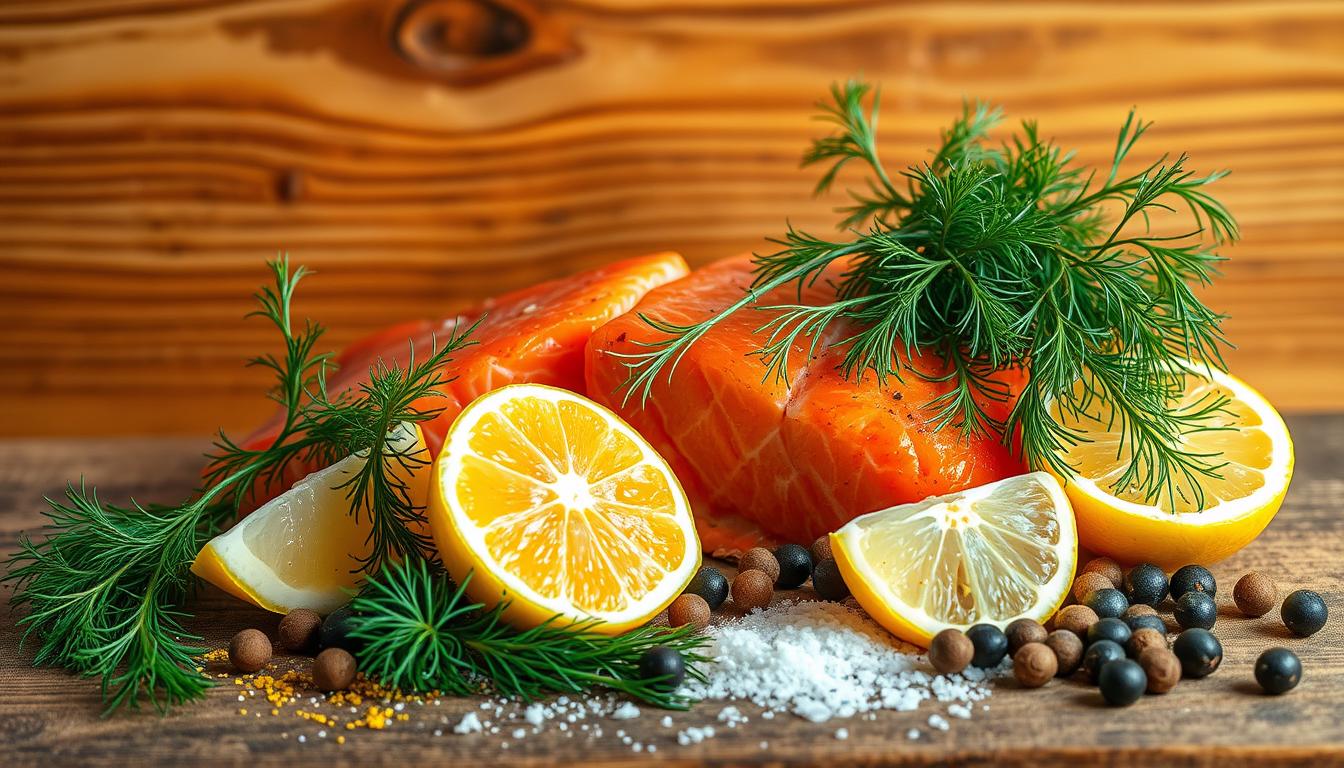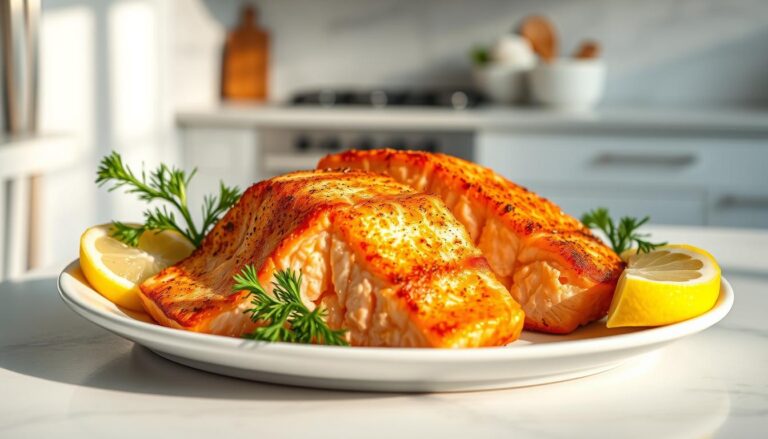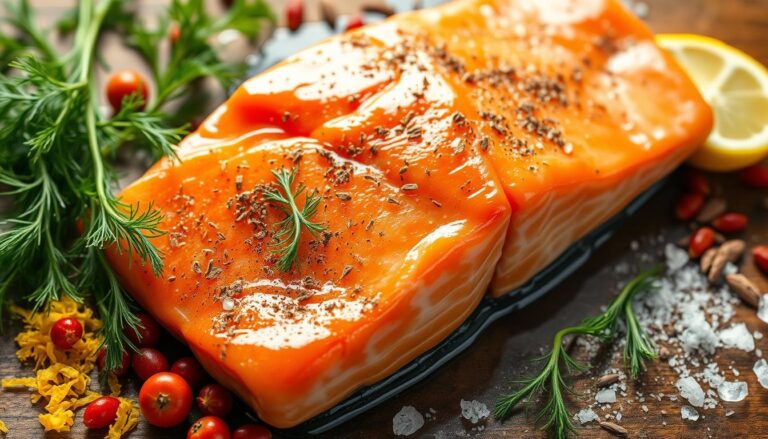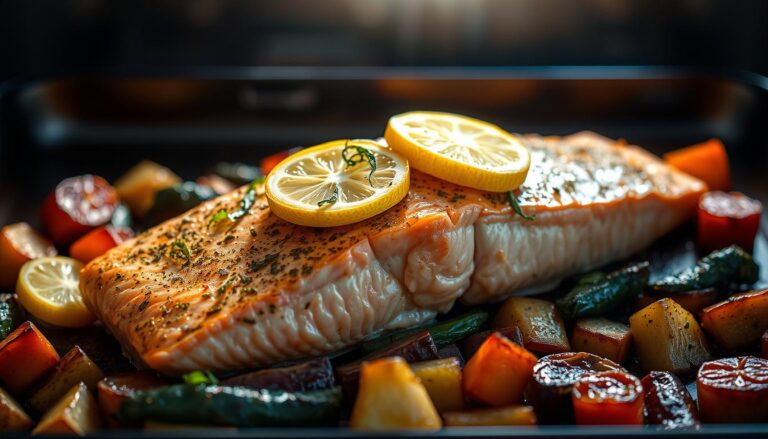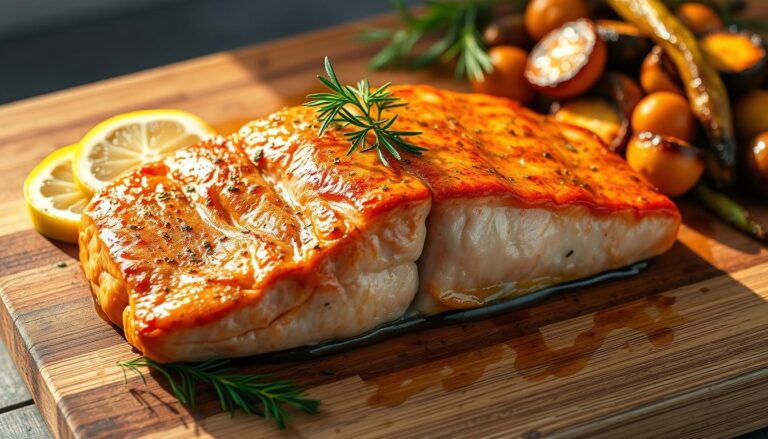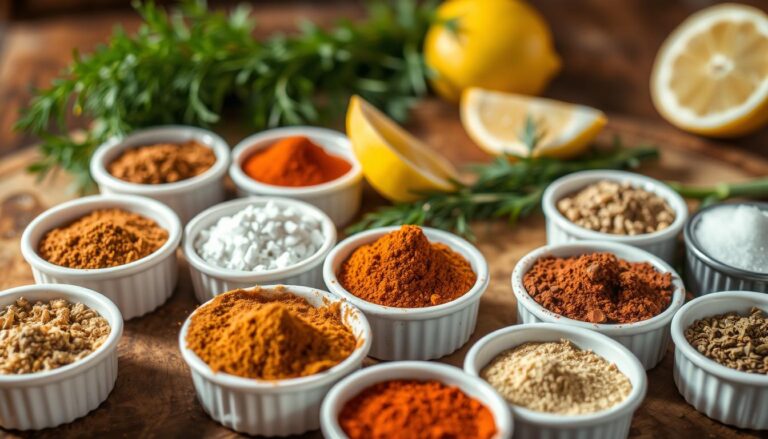Flavorful Salmon Seasoning: Top Healthy Spice Picks
Table of Contents
Flavorful Salmon Seasoning: Top Healthy Spice Picks
There’s something magical about a perfectly seasoned piece of salmon. Its natural richness, combined with the right blend of ingredients, can transform a simple meal into a culinary masterpiece. Whether you’re grilling, baking, or pan-frying, the right seasoning enhances the fish’s flavor while keeping it healthy and delicious.
Salmon is packed with protein and omega-3 fatty acids, making it a nutritious choice for any meal. By using simple yet flavorful combinations like lemon, garlic, and salt, you can bring out its best qualities. Adding a touch of smoked paprika or citrus zest can elevate the dish even further, creating a balance of sweet, savory, and smoky notes.
Homemade seasoning blends are not only cost-effective but also allow you to control the ingredients. With 97% of readers rating these recipes 5 stars, it’s clear that a little creativity in the kitchen goes a long way. Let’s explore how to make your salmon dishes unforgettable.
Key Takeaways
- Proper seasoning enhances salmon’s natural richness and flavor.
- Salmon is a high-protein, omega-3-rich fish that’s both healthy and versatile.
- Balancing sweet, savory, and smoky flavors creates a well-rounded dish.
- Homemade seasoning blends are cost-effective and customizable.
- Popular spices include smoked paprika, garlic, and citrus zests.
Introduction to Salmon Seasoning
Salmon’s natural oils make it a standout choice for seasoning. Its high-fat content allows it to absorb flavors deeply, creating a rich and satisfying taste. Unlike leaner fish, salmon’s texture ensures that every bite is infused with your chosen seasoning.
Understanding the science behind flavor absorption is key. Fatty fish like salmon retain marinades and dry rubs better than their lean counterparts. This makes it easier to experiment with bold combinations, from smoky paprika to zesty citrus blends.
When it comes to application, you have options. Dry rubs are perfect for a quick, flavorful crust, while marinades penetrate the fish for deeper taste. Finishing spices, like fresh herbs, add a burst of flavor just before serving.
However, be cautious with acidic ingredients like lemon juice. Over-marinating can break down the fish’s texture, so limit citrus-based mixes to under 30 minutes. This ensures your salmon remains tender and flavorful.
Homemade blends offer a fresher, preservative-free alternative to store-bought options. They also allow you to customize your recipes to suit your taste. Store-bought seasonings, while convenient, often contain additives that can alter the natural flavor of the fish.
Texture plays a role too. Skin-on salmon holds spices better, while skinless fillets require a lighter touch. Professional chefs recommend patting the fish dry before applying any seasoning to ensure even adherence.
Always handle raw salmon with care. Keep it refrigerated until ready to use, and avoid cross-contamination with other ingredients. Pairing the right cooking oil with your method—olive oil for baking, avocado oil for grilling—can enhance the overall experience.
| Method | Best Oil | Flavor Impact |
|---|---|---|
| Baking | Olive Oil | Mild, Enhances Herbs |
| Grilling | Avocado Oil | Rich, Smoky Notes |
| Pan-Frying | Butter | Creamy, Buttery Finish |
With these tips, you’re ready to master the art of cooking perfectly seasoned salmon. Whether you’re grilling, baking, or pan-frying, the right techniques will elevate your dish to new heights.
What Spices to Put on Salmon: A Comprehensive Guide
Choosing the right blend of flavors can turn a simple salmon dish into a gourmet experience. The key lies in selecting spices that complement its natural richness while adding depth and complexity. Whether you’re aiming for a smoky, sweet, or savory profile, the right combination can elevate your meal.
Essential Spices for Salmon
Every kitchen should have these six core spices for seasoning salmon: garlic, paprika, lemon, pepper, thyme, and brown sugar. Garlic, whether fresh or powdered, adds a robust flavor. Use 1 teaspoon of powder or 2 cloves of fresh garlic per fillet.
Paprika comes in sweet, smoked, and hot varieties. Smoked paprika replicates grill-like flavors, while sweet paprika adds mild warmth. For a balanced taste, use ½ teaspoon per serving.
Lemon zest or juice brightens the dish. Zest adds aroma without altering texture, while juice should be applied sparingly to avoid over-marinating. A pinch of pepper and thyme enhances the overall profile.
Sweet and Savory Combinations
Balancing sweet and savory elements is crucial. Brown sugar prevents burning during indirect heat cooking and pairs well with acidic ingredients like lemon. Use a 1:1 ratio for a harmonious blend.
Dried basil not only adds flavor but also increases the shelf life of your seasoning mix. Combine it with thyme and garlic for a Mediterranean-inspired rub. For an Asian twist, add ginger and soy sauce.
Here’s a quick-reference flavor pairing chart:
| Flavor Profile | Spices | Ratio |
|---|---|---|
| Smoky | Smoked Paprika, Garlic, Pepper | 1:1:1 |
| Sweet & Savory | Brown Sugar, Thyme, Lemon Zest | 1:1:1 |
| Asian-Inspired | Ginger, Soy Sauce, Garlic | 1:1:1 |
For allergy-friendly options, replace garlic with chives or paprika with turmeric. Experiment with regional variations to discover your perfect blend.
Homemade Salmon Seasoning Recipe
Crafting your own salmon seasoning at home is easier than you think. With just a few simple ingredients, you can create a flavorful mix that enhances the natural taste of the fish. This recipe is perfect for a 2-lb fillet and takes only 5 minutes to prepare.
Ingredients You’ll Need
Here’s what you’ll need to make this versatile rub:
- 2 tablespoons brown sugar (break clumps for even mixing)
- 2 teaspoons black pepper
- 1 teaspoon smoked paprika
- 1 teaspoon garlic powder
- 1 teaspoon dried thyme
- Zest of 1 lemon (preserve by storing in an airtight container)
Step-by-Step Instructions
Follow these simple instructions for the perfect blend:
- Add all ingredients to a bowl.
- Use a fork to break any clumps in the brown sugar.
- Mix thoroughly until evenly combined.
- Apply the rub generously to your salmon fillet.
For bulk preparation, double or triple the recipe and store in a glass jar. This seasoning stays fresh for up to 6 months. Use coarse salt for a better texture and avoid fine salt to prevent over-salting.
Pro Tip: If you’re out of lemon zest, substitute with a splash of lime juice. Always clean citrus residue promptly to avoid sticky surfaces.
How to Use Salmon Seasoning
Mastering the art of salmon seasoning starts with knowing how to apply it effectively. Whether you’re grilling or baking, the right techniques ensure your fillets are flavorful and perfectly cooked. Let’s dive into the best methods for each cooking style.

Grilling Tips
Grilling salmon requires attention to heat control. For charcoal grills, maintain a two-zone setup to prevent burning. Place the fillets on the cooler side for indirect cooking. Gas grills offer better temperature regulation, so aim for medium-high heat.
To achieve crispy skin, pat the fillets dry before applying your rub. Place them skin-side down directly over the flame for 2-3 minutes, then move to indirect heat. Cedar planks add a smoky flavor, while direct grilling gives a charred crust.
Internal temperature is key. Aim for 145°F for perfectly cooked salmon. Remember, carryover cooking will raise the temperature by 5°F after removing it from the grill.
Baking Instructions
Baking salmon in the oven is simple and consistent. Preheat your oven to 375°F. Line a baking sheet with parchment paper or foil for easy cleanup. Brush the fillets with olive oil to lock in moisture.
Apply your seasoning generously, ensuring even coverage. Bake for 20-25 minutes, or until the salmon flakes easily with a fork. For added flavor, use a glass or ceramic baking dish, which retains heat better than metal.
Residual heat can be utilized by letting the salmon rest for 5 minutes after baking. This allows the flavors to meld and ensures a tender texture.
Storing Your Salmon Seasoning
Proper storage of your salmon seasoning ensures it stays fresh and flavorful for every use. Whether you’ve made a large batch or a small mix, keeping it in the right conditions is key to maintaining its quality.
Glass jars are the best option for storing your seasoning. They keep moisture out and preserve the aroma of your mix. Avoid plastic containers, as they can absorb odors and affect the flavor over time.
Humidity control is essential. Use silica gel packets or rice grains in your storage container to prevent clumping. This is especially important if your kitchen tends to be humid.
For long-term storage, consider freezing your seasoning. Freezer-safe glass jars or resealable bags work well. In the pantry, your mix can last up to 6 months, while the freezer extends its shelf life to a year.
Here’s a quick comparison of storage methods:
| Storage Method | Shelf Life | Best Container |
|---|---|---|
| Pantry | 6 Months | Glass Jar |
| Freezer | 1 Year | Freezer-Safe Bag |
To prevent clumps, store your seasoning in a cool, dark place. Avoid exposing it to direct sunlight or heat sources. Label your containers with the date and contents for easy information tracking.
If your seasoning loses its aroma or develops an off smell, it’s time to replace it. Stale blends can still be repurposed for soups or stews, adding depth to other dishes.
By following these tips, you’ll keep your salmon seasoning fresh and ready to enhance your meals whenever you need it.
Alternative Seasoning Ideas for Salmon
Exploring diverse seasoning options can transform your salmon into a global culinary adventure. Whether you’re craving Mediterranean herbs, Asian-inspired sauces, or fiery cajun seasoning, there’s a flavor profile for every palate. Let’s dive into creative ways to elevate your recipes.

Mediterranean Flavor Profile
Mediterranean seasoning blends bring a fresh, herbaceous touch to your salmon. A classic za’atar mix includes sesame seeds, sumac, and thyme. Pair it with olive oil for a simple yet flavorful marinade. For a creamy twist, try a tahini-based sauce with lemon juice and garlic.
- Za’atar blend: sesame seeds, sumac, thyme
- Tahini sauce: tahini, lemon juice, garlic
- Harissa paste: 1 tbsp per fillet for a smoky kick
Asian-Inspired Seasonings
Asian flavors add depth and umami to your salmon. Miso paste is a versatile option, blending well with soy sauce and ginger. For a sweet and tangy glaze, try a teriyaki combo with mirin, soy, and brown sugar. Gochujang and sriracha offer varying levels of heat for those who love spice.
| Ingredient | Flavor Profile |
|---|---|
| Miso Paste | Savory, Umami |
| Gochujang | Spicy, Sweet |
| Sriracha | Fiery, Tangy |
Hot and Spicy Options
For those who crave heat, cajun seasoning is a bold choice. Combine paprika, garlic powder, and cayenne pepper for a fiery rub. Harissa, a North African chili paste, adds smoky heat with a touch of sweetness. Always test spice levels to suit your tolerance.
“Spice is the soul of flavor—use it wisely to enhance, not overpower.”
- Cajun seasoning: paprika, garlic powder, cayenne
- Harissa: 1 tbsp per fillet
- Regional peppers: Aleppo, Ancho, or Chipotle
These alternative seasoning ideas cater to diverse tastes and dietary preferences. Whether you’re experimenting with Mediterranean herbs, Asian-inspired sauces, or fiery blends, your salmon dishes will never be boring.
Tips for Cooking Perfectly Seasoned Salmon
Achieving perfectly seasoned salmon requires a blend of technique and timing. Start by patting your fillets dry with a paper towel. This removes excess moisture, ensuring your seasoning adheres well and prevents steaming during cooking.
For even cooking, score the skin in a crosshatch pattern. This allows heat to penetrate evenly and prevents curling. Whether you’re grilling or pan-searing, always start skin-side down to render the fat and achieve a crispy texture.
Pan-searing requires precise temperature control. Heat your pan to medium-high and use olive oil to prevent sticking. Cook for 3-4 minutes on each side, depending on thickness. A resting period of 5 minutes enhances flavor and ensures juiciness.
Compound butter is a chef’s secret for adding richness. Mix softened butter with herbs, garlic, or citrus zest, then spread it over the salmon just before serving. This adds a luxurious finish to your dish.
Common misconceptions about doneness can lead to overcooking. Salmon is done when it reaches an internal temperature of 145°F and flakes easily. If you accidentally overcook, salvage it by flaking the fish into a salad or pasta.
When sourcing salmon, look for sustainable identifiers like MSC or ASC certifications. This ensures you’re making an environmentally conscious choice. For presentation, plate your salmon with vibrant sides like roasted vegetables or a citrus salad.
“Perfectly cooked salmon is about balance—timing, technique, and quality ingredients.”
By following these tips, you’ll master the art of cooking salmon that’s flavorful, tender, and visually appealing. Every step, from preparation to plating, contributes to a memorable meal.
Conclusion
Unlock endless possibilities in your kitchen by experimenting with salmon seasoning. With over 500 variations, there’s no limit to the flavor profiles you can create. Homemade blends are not only cost-effective but also healthier, letting you control every ingredient.
Take a moment to audit your spice cabinet. Rotate seasonal ingredients to keep your recipes fresh and exciting. Share your creations on social media to inspire others and connect with fellow food enthusiasts.
Pair your seasoned salmon with complementary sides like roasted vegetables or citrus salads. For expert tips, download our free recipe cards or explore upcoming flavor guides. Remember, a well-balanced meal is as nutritious as it is delicious.
FAQ
What are the best spices for salmon?
How do you make homemade salmon seasoning?
Can you use olive oil with salmon seasoning?
How long should you bake seasoned salmon?
What’s a good sweet and savory seasoning for salmon?
How do you store leftover salmon seasoning?
What’s a quick way to season salmon for grilling?
Are there low-sodium seasoning options for salmon?
Can you use cajun seasoning on salmon?
What’s a Mediterranean-inspired seasoning for salmon?
For more cooking tips, stay connected with us. We also recommend the cookbook Skinnytaste Simple: Easy, Healthy Recipes with 7 Ingredients or Fewer
For more Recipes about Salmon
